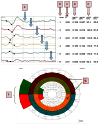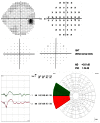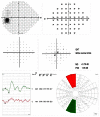The role of hemifield sector analysis in multifocal visual evoked potential objective perimetry in the early detection of glaucomatous visual field defects
- PMID: 23690675
- PMCID: PMC3656925
- DOI: 10.2147/OPTH.S44009
The role of hemifield sector analysis in multifocal visual evoked potential objective perimetry in the early detection of glaucomatous visual field defects
Abstract
Objective: The purpose of this study was to examine the effectiveness of a new analysis method of mfVEP objective perimetry in the early detection of glaucomatous visual field defects compared to the gold standard technique.
Methods and patients: Three groups were tested in this study; normal controls (38 eyes), glaucoma patients (36 eyes), and glaucoma suspect patients (38 eyes). All subjects underwent two standard 24-2 visual field tests: one with the Humphrey Field Analyzer and a single mfVEP test in one session. Analysis of the mfVEP results was carried out using the new analysis protocol: the hemifield sector analysis protocol.
Results: Analysis of the mfVEP showed that the signal to noise ratio (SNR) difference between superior and inferior hemifields was statistically significant between the three groups (analysis of variance, P < 0.001 with a 95% confidence interval, 2.82, 2.89 for normal group; 2.25, 2.29 for glaucoma suspect group; 1.67, 1.73 for glaucoma group). The difference between superior and inferior hemifield sectors and hemi-rings was statistically significant in 11/11 pair of sectors and hemi-rings in the glaucoma patients group (t-test P < 0.001), statistically significant in 5/11 pairs of sectors and hemi-rings in the glaucoma suspect group (t-test P < 0.01), and only 1/11 pair was statistically significant (t-test P < 0.9). The sensitivity and specificity of the hemifield sector analysis protocol in detecting glaucoma was 97% and 86% respectively and 89% and 79% in glaucoma suspects. These results showed that the new analysis protocol was able to confirm existing visual field defects detected by standard perimetry, was able to differentiate between the three study groups with a clear distinction between normal patients and those with suspected glaucoma, and was able to detect early visual field changes not detected by standard perimetry. In addition, the distinction between normal and glaucoma patients was especially clear and significant using this analysis.
Conclusion: The new hemifield sector analysis protocol used in mfVEP testing can be used to detect glaucomatous visual field defects in both glaucoma and glaucoma suspect patients. Using this protocol, it can provide information about focal visual field differences across the horizontal midline, which can be utilized to differentiate between glaucoma and normal subjects. The sensitivity and specificity of the mfVEP test showed very promising results and correlated with other anatomical changes in glaucomatous visual field loss. The intersector analysis protocol can detect early field changes not detected by the standard Humphrey Field Analyzer test.
Keywords: HFA; SAP; glaucoma suspect; glaucomatous field loss; multifocal VEP; objective perimetry; visual field testing.
Figures











Similar articles
-
Evaluation of hemifield sector analysis protocol in multifocal visual evoked potential objective perimetry for the diagnosis and early detection of glaucomatous field defects.Korean J Ophthalmol. 2014 Feb;28(1):49-65. doi: 10.3341/kjo.2014.28.1.49. Epub 2014 Jan 21. Korean J Ophthalmol. 2014. PMID: 24511212 Free PMC article.
-
Multifocal VEP and ganglion cell damage: applications and limitations for the study of glaucoma.Prog Retin Eye Res. 2003 Mar;22(2):201-51. doi: 10.1016/s1350-9462(02)00061-7. Prog Retin Eye Res. 2003. PMID: 12604058 Review.
-
Frequency-doubling technology perimetry and multifocal visual evoked potential in glaucoma, suspected glaucoma, and control patients.Clin Ophthalmol. 2014 Jul 14;8:1323-30. doi: 10.2147/OPTH.S64684. eCollection 2014. Clin Ophthalmol. 2014. PMID: 25075173 Free PMC article.
-
Comparing multifocal VEP and standard automated perimetry in high-risk ocular hypertension and early glaucoma.Invest Ophthalmol Vis Sci. 2007 Mar;48(3):1173-80. doi: 10.1167/iovs.06-0561. Invest Ophthalmol Vis Sci. 2007. PMID: 17325161
-
[New insights into the pathogenesis of glaucomatous optic neuropathy and refinement of the objective assessment of its functional damage].Nippon Ganka Gakkai Zasshi. 2012 Mar;116(3):298-344; discussion 345-6. Nippon Ganka Gakkai Zasshi. 2012. PMID: 22568105 Review. Japanese.
Cited by
-
Steady-state multifocal visual evoked potential (ssmfVEP) using dartboard stimulation as a possible tool for objective visual field assessment.Graefes Arch Clin Exp Ophthalmol. 2016 Feb;254(2):259-68. doi: 10.1007/s00417-015-3214-9. Epub 2015 Nov 9. Graefes Arch Clin Exp Ophthalmol. 2016. PMID: 26553198
-
Pattern Electroretinogram Detects Localized Glaucoma Defects.Transl Vis Sci Technol. 2018 Sep 13;7(5):6. doi: 10.1167/tvst.7.5.6. eCollection 2018 Sep. Transl Vis Sci Technol. 2018. PMID: 30221072 Free PMC article.
-
Correlation of pattern reversal visual evoked potential parameters with the pattern standard deviation in primary open angle glaucoma.Int J Ophthalmol. 2014 Apr 18;7(2):326-9. doi: 10.3980/j.issn.2222-3959.2014.02.24. eCollection 2014. Int J Ophthalmol. 2014. PMID: 24790879 Free PMC article.
-
Accuracy of isolated-check visual evoked potential technique for diagnosing primary open-angle glaucoma.Doc Ophthalmol. 2017 Oct;135(2):107-119. doi: 10.1007/s10633-017-9598-6. Epub 2017 Jul 12. Doc Ophthalmol. 2017. PMID: 28702796
References
-
- Kerrigan-Baumrind LA, Quigley HA, Pearse ME, Kerrigan DF, Mitchell RS. Number of ganglion cells in glaucoma eyes compared with threshold visual field tests in the same persons. Invest Ophthalmol Vis Sci. 2000;41(3):741–748. - PubMed
-
- Quigley HA, Dunkelberger GR, Green WR. Retinal ganglion cell atrophy correlated with automated perimetry in human eyes with glaucoma. Am J Ophthalmol. 1989;107(5):453–464. - PubMed
-
- McKendrick AM, Turpin A. Combining perimetric suprathreshold and threshold procedures to reduce measurement variability in areas of visual field loss. Optom Vis Sci. 2005;82(1):43–51. - PubMed
-
- Graham SL, Klistorner AI, Grigg JR, Billson FA. Objective perimetry in glaucoma: recent advances with multifocal stimuli. Surv Ophthalmol. 1999;43(Suppl 1):S199–S209. - PubMed
-
- Graham SL, Klistorner AI, Goldberg I. Clinical application of objective perimetry using multifocal visual evoked potentials in glaucoma practice. Arch Ophthalmol. 2005;123(6):729–739. - PubMed
LinkOut - more resources
Full Text Sources
Other Literature Sources
Miscellaneous

